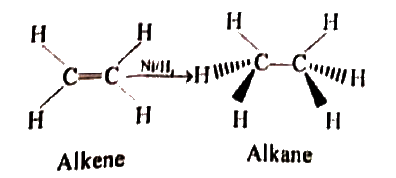Explain how transition metals and their compounds act as catalysts.
Transition metal has energetically available .d. orbitals that can accept electrons from reactant molecule or metal can form bond with reactant molecule using its .d. electrons. For example, in the catalytic hydrogentation of an alkene, the alkene bonds to an active site by using its π electrons with empty .d. orbital of the catalyst. The σ bond in the hydrogen molecule breaks, and each hydrogen atom forms a bond with a .d. electron on an atom in the catalyst. The two hydrogen atoms then bond with the partially broken π - bond in the alkene to form an alkane.

Topper's Solved these Questions
- TRANSITION AND INNER TRANSITION ELEMENTS BOOK - PREMIERS PUBLISHERSCHAPTER - TRANSITION AND INNER TRANSITION ELEMENTS EXERCISE - OTHER IMPORTANT QUESTIONS & ANSWERS (I. Choose the correct answer)
27 Videos
- SURFACE CHEMISTRYBOOK - PREMIERS PUBLISHERSCHAPTER - SURFACE CHEMISTRYEXERCISE - OTHER IMPORTANT QUESTIONS & ANSWERS (II. Answer the following questions:)
57 Videos
Similar Questions
Explain why :
Transition metals and their compounds act as catalyst.
View SolutionHow would you account for the following?
(l) Transition metals exhibit variable oxidation states.
(ii) Zr (Z = 40) and Hf (Z = 72) have almost identical radii.
(iii) Transition metals and their compounds act as catalyst.
View SolutionExplain why transition metals and their many compounds act as good catalyst.
View SolutionExplain why transition metals and their many compounds act as good catalyst.
View SolutionExplain why transition metals and their many compounds act as goodd catalyst.
View Solution(a) Members of second and third transition series exhibit similar atomic radii. Explain. (b) Account for the following: (i) Transition metals and their many compounds act as good catalysts. (ii) Actinoids has greater tendency to form complexes in comparison to Lanthanoids.
View SolutionExplain giving reasons :
(i) Transition metals and many of their compounds show paramagnetic beaviour.
(ii) The enthalpies of atomisation of the transition metals are high.
(iii) The transition metals generally form coloured compounds.
(iv) Transition metals and their many compounds act as good catalyst.
View SolutionWhich of the following statement(s) is/are correct?
(A) Transition metals and many of their compounds show paramagnetic behaviour.
(B) The enthapies of atomisation of the transition metals are high
(B) The transition metals generally form coloured compounds
(D) Transition metals and their many compounds act as good catalyst.
View SolutionAssign reasons for the following :
(i) Transition metals and many fo their compounds act as good catalyst.
(ii) Transition metals generally from coloured compounds.
View SolutionAssign reasons for the following :
(i) Transition metals and many fo their compounds act as good catalyst.
(ii) Transition metals generally from coloured compounds.
View Solution
